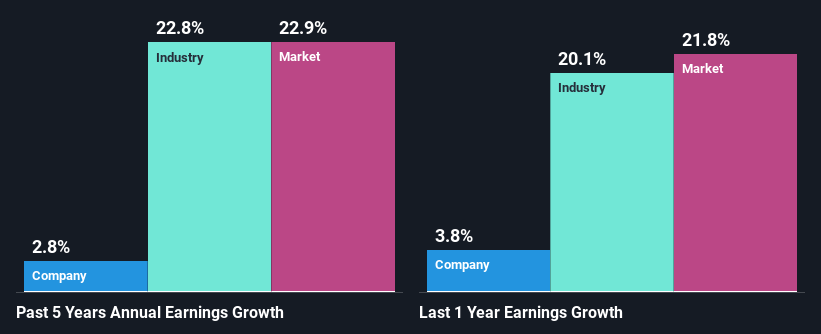- India
- /
- Auto Components
- /
- NSEI:EXIDEIND
Are Exide Industries Limited's (NSE:EXIDEIND) Mixed Financials The Reason For Its Gloomy Performance on The Stock Market?
It is hard to get excited after looking at Exide Industries' (NSE:EXIDEIND) recent performance, when its stock has declined 13% over the past three months. We, however decided to study the company's financials to determine if they have got anything to do with the price decline. Long-term fundamentals are usually what drive market outcomes, so it's worth paying close attention. Particularly, we will be paying attention to Exide Industries' ROE today.
ROE or return on equity is a useful tool to assess how effectively a company can generate returns on the investment it received from its shareholders. Simply put, it is used to assess the profitability of a company in relation to its equity capital.
Check out our latest analysis for Exide Industries
How Is ROE Calculated?
The formula for ROE is:
Return on Equity = Net Profit (from continuing operations) ÷ Shareholders' Equity
So, based on the above formula, the ROE for Exide Industries is:
6.8% = ₹8.8b ÷ ₹129b (Based on the trailing twelve months to June 2024).
The 'return' is the profit over the last twelve months. That means that for every ₹1 worth of shareholders' equity, the company generated ₹0.07 in profit.
What Has ROE Got To Do With Earnings Growth?
So far, we've learned that ROE is a measure of a company's profitability. Based on how much of its profits the company chooses to reinvest or "retain", we are then able to evaluate a company's future ability to generate profits. Generally speaking, other things being equal, firms with a high return on equity and profit retention, have a higher growth rate than firms that don’t share these attributes.
Exide Industries' Earnings Growth And 6.8% ROE
It is hard to argue that Exide Industries' ROE is much good in and of itself. Even compared to the average industry ROE of 12%, the company's ROE is quite dismal. Accordingly, Exide Industries' low net income growth of 2.8% over the past five years can possibly be explained by the low ROE amongst other factors.
We then compared Exide Industries' net income growth with the industry and found that the company's growth figure is lower than the average industry growth rate of 23% in the same 5-year period, which is a bit concerning.

Earnings growth is a huge factor in stock valuation. What investors need to determine next is if the expected earnings growth, or the lack of it, is already built into the share price. This then helps them determine if the stock is placed for a bright or bleak future. One good indicator of expected earnings growth is the P/E ratio which determines the price the market is willing to pay for a stock based on its earnings prospects. So, you may want to check if Exide Industries is trading on a high P/E or a low P/E, relative to its industry.
Is Exide Industries Efficiently Re-investing Its Profits?
A low three-year median payout ratio of 20% (implying that the company retains the remaining 80% of its income) suggests that Exide Industries is retaining most of its profits. However, the low earnings growth number doesn't reflect this as high growth usually follows high profit retention. So there might be other factors at play here which could potentially be hampering growth. For example, the business has faced some headwinds.
Additionally, Exide Industries has paid dividends over a period of at least ten years, which means that the company's management is determined to pay dividends even if it means little to no earnings growth. Our latest analyst data shows that the future payout ratio of the company over the next three years is expected to be approximately 16%. However, Exide Industries' ROE is predicted to rise to 10% despite there being no anticipated change in its payout ratio.
Conclusion
Overall, we have mixed feelings about Exide Industries. Even though it appears to be retaining most of its profits, given the low ROE, investors may not be benefitting from all that reinvestment after all. The low earnings growth suggests our theory correct. With that said, the latest industry analyst forecasts reveal that the company's earnings are expected to accelerate. To know more about the latest analysts predictions for the company, check out this visualization of analyst forecasts for the company.
Valuation is complex, but we're here to simplify it.
Discover if Exide Industries might be undervalued or overvalued with our detailed analysis, featuring fair value estimates, potential risks, dividends, insider trades, and its financial condition.
Access Free AnalysisHave feedback on this article? Concerned about the content? Get in touch with us directly. Alternatively, email editorial-team (at) simplywallst.com.
This article by Simply Wall St is general in nature. We provide commentary based on historical data and analyst forecasts only using an unbiased methodology and our articles are not intended to be financial advice. It does not constitute a recommendation to buy or sell any stock, and does not take account of your objectives, or your financial situation. We aim to bring you long-term focused analysis driven by fundamental data. Note that our analysis may not factor in the latest price-sensitive company announcements or qualitative material. Simply Wall St has no position in any stocks mentioned.
About NSEI:EXIDEIND
Exide Industries
Designs, manufactures, markets, and sells lead acid storage batteries in India and internationally.
Excellent balance sheet with questionable track record.
Similar Companies
Market Insights
Community Narratives



